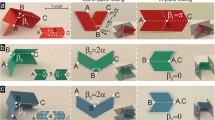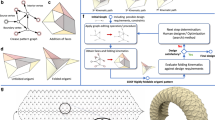Abstract
What forms of origami can be designed automatically by algorithms? What shapes can result by folding a piece of paper flat and making one complete straight cut? What polyhedra can be cut along their surface and unfolded into a flat piece of paper without overlap? When can a linkage of rigid bars be untangled or folded into a desired configuration? Folding and unfolding is a branch of discrete and computational geometry that addresses these and many other intriguing questions. I will give a taste of the many results that have been proved in the past few years, as well as the several exciting open problems that remain open. Many folding problems have applications in areas including manufacturing, robotics, graphics, and protein folding.
Similar content being viewed by others
Author information
Authors and Affiliations
Editor information
Editors and Affiliations
Rights and permissions
Copyright information
© 2006 Springer-Verlag Berlin Heidelberg
About this paper
Cite this paper
Demaine, E.D. (2006). Origami, Linkages, and Polyhedra: Folding with Algorithms. In: Azar, Y., Erlebach, T. (eds) Algorithms – ESA 2006. ESA 2006. Lecture Notes in Computer Science, vol 4168. Springer, Berlin, Heidelberg. https://doi.org/10.1007/11841036_1
Download citation
DOI: https://doi.org/10.1007/11841036_1
Publisher Name: Springer, Berlin, Heidelberg
Print ISBN: 978-3-540-38875-3
Online ISBN: 978-3-540-38876-0
eBook Packages: Computer ScienceComputer Science (R0)




